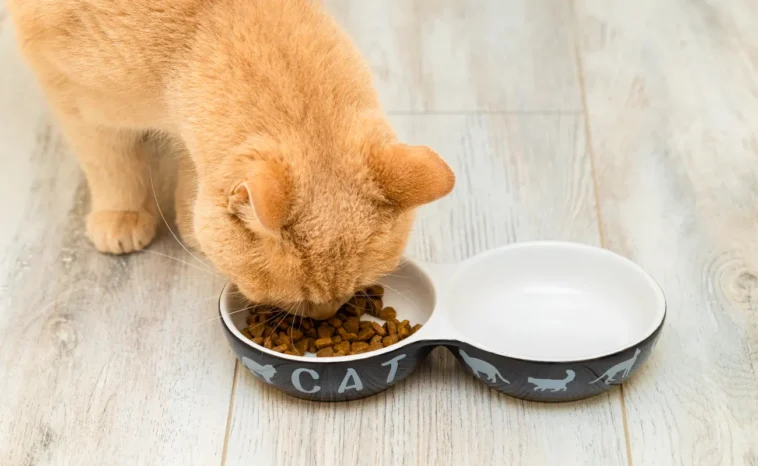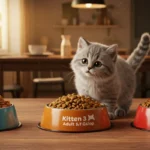Are you ready to discover the ultimate secret to your kitten’s thriving health? The best wet cat food for kittens isn’t just about satisfying your furry friend’s taste buds—it’s about providing the essential nutrients that support growth, development, and overall well-being. In this article, we dive deep into why choosing the best wet cat food for kittens is crucial for every pet parent, how to evaluate ingredients and nutritional benefits, and practical tips to overcome common feeding challenges. Along the way, you’ll find a helpful internal resource—Can Kittens Eat Cat Food? Everything You Need to Know to Keep Your Kitten Healthy—that further guides your journey into optimal cat food selection. Whether you’re a new kitten owner or a seasoned cat lover, this comprehensive guide on the best wet cat food for kittens is designed to equip you with all the essential information to ensure your little feline friend grows up healthy and happy.
In the following sections, we’ll explore an in-depth overview of the topic, key nutritional considerations, frequently asked questions, practical tips, common challenges with corresponding solutions, and the undeniable benefits of choosing the right wet cat food for kittens. By the end of this article, you will have a clear roadmap to making an informed decision about feeding your beloved CATS the very best cat food available.
Overview
Wet cat food has become increasingly popular among pet parents, and for good reason. Unlike dry food, wet food provides a higher moisture content that is essential for kittens, whose delicate systems and developing bodies require a balanced diet with the right hydration levels. In this overview, we will discuss:
- The importance of proper nutrition for kittens: As kittens grow rapidly in their first year, every bite counts. Their nutritional needs are unique and require a balanced blend of proteins, fats, vitamins, and minerals.
- Differences between wet and dry food: Wet food mimics the natural prey diet of cats, offering higher water content which is beneficial for urinary tract health.
- Quality control and ingredient sourcing: With numerous brands on the market, understanding labels and choosing products with high-quality, natural ingredients is critical.
- The role of wet food in your kitten’s diet: Incorporating wet food can complement dry food, providing variety in texture and taste while enhancing overall nutrient absorption.
The growing consensus among veterinarians and pet nutrition experts is that wet cat food offers several advantages over traditional dry food, especially during the crucial developmental stages of a kitten’s life.
Nutritional Considerations for Best Wet Cat Food for Kittens
When selecting the best wet cat food for kittens, it’s vital to focus on the nutritional composition that will foster healthy growth. Here are some essential considerations:
High-Quality Protein
Kittens require a protein-rich diet to support rapid growth and muscle development. Look for products where animal protein (chicken, turkey, beef, or fish) is listed as the primary ingredient. This is crucial because proteins provide the amino acids necessary for tissue repair and immune function.
Essential Fats and Omega Fatty Acids
Fats are an important energy source, and essential fatty acids like Omega-3 and Omega-6 support skin health, brain development, and a shiny coat. A balanced wet cat food should contain these fats to help ensure your kitten’s developing brain and nervous system function properly.
Moisture and Hydration
One of the biggest advantages of wet cat food is its high moisture content. Proper hydration is key for kidney health and helps prevent urinary tract issues, which are common in CATS. Moisture in wet food aids digestion and keeps your kitten well-hydrated, particularly if they are not drinking enough water on their own.
Vitamins and Minerals
A complete and balanced wet cat food should include essential vitamins like A, D, and E, along with minerals such as calcium, phosphorus, and taurine. Taurine, in particular, is an essential amino acid that is critical for vision, heart health, and overall growth in kittens. Make sure the label indicates a balanced profile to meet your kitten’s dietary needs.
Avoiding Unnecessary Additives
While some additives might enhance flavor or preserve freshness, it’s best to avoid wet cat food products that contain excessive artificial colors, flavors, or preservatives. Natural ingredients not only provide better nutrition but also reduce the risk of allergies or digestive upset in sensitive kittens.
Ingredient Transparency and Sourcing
Check the packaging for information about ingredient sourcing. Brands that emphasize transparency—revealing where and how the ingredients are procured—often adhere to higher quality standards. This is especially important for kittens, who are more sensitive to low-quality ingredients.
Common Questions About Best Wet Cat Food for Kittens
Selecting the best wet cat food for kittens often raises many questions. Here, we address some of the most frequently asked concerns:
What makes wet cat food better than dry food for kittens?
Wet cat food offers a higher moisture content, which is beneficial for hydration and urinary tract health. It also typically contains more natural proteins and fats, which are essential for the rapid growth and development of kittens.
How often should I feed wet food to my kitten?
Kittens generally require small, frequent meals throughout the day. Wet food can be offered alongside dry food or as a standalone meal, depending on your kitten’s preferences and nutritional needs. Consult with your veterinarian for personalized feeding schedules.
Are there specific ingredients I should avoid?
Yes. Avoid products that contain artificial additives, fillers like corn or wheat gluten, and by-products that do not contribute to a balanced diet. Always opt for brands that provide clear, high-quality ingredient lists.
How do I transition my kitten to wet food?
Start by mixing a small amount of wet food into their current diet. Gradually increase the proportion of wet food over a week or two until your kitten is fully transitioned. This helps avoid digestive upset and ensures acceptance of the new texture and flavor.
Is wet food more expensive than dry food?
Wet food tends to be more expensive per serving due to the higher quality ingredients and production processes involved. However, the health benefits, especially for growing kittens, often outweigh the additional cost.
Tips for Choosing the Right Wet Cat Food for Kittens
Choosing the right wet cat food for kittens involves careful consideration of several factors. Here are some actionable tips to guide you through the selection process:
-
Examine the Ingredient List:
- Prioritize high-quality animal protein as the first ingredient.
- Ensure the food includes essential fatty acids and vitamins.
- Avoid fillers and artificial additives.
-
Read the Nutritional Information:
- Look for AAFCO (Association of American Feed Control Officials) approval or equivalent nutritional certification.
- Check that the product offers a balanced profile specifically designed for kittens.
-
Consider Texture and Palatability:
- Some kittens may have preferences for pate, shredded, or chunks in gravy.
- Offer variety to prevent picky eating and ensure nutritional diversity.
-
Consult Reviews and Expert Opinions:
- Read reviews from other pet owners and look for expert recommendations from veterinarians.
- Internal resources such as our Can Kittens Eat Cat Food? Everything You Need to Know to Keep Your Kitten Healthy can provide additional insights.
-
Trial and Observation:
- Purchase small packages initially to see how your kitten reacts.
- Monitor their energy levels, coat condition, and overall health.
-
Budget Considerations:
- While premium products might be costlier, the long-term benefits for your kitten’s health can make them a worthwhile investment.
- Compare prices and consider subscription services that might offer discounts for high-quality brands.
-
Consult with Your Veterinarian:
- Every kitten is unique; always consult a vet to tailor the diet to your pet’s specific needs.
- Regular check-ups can help adjust the food intake as your kitten grows.
Challenges and Solutions Related to Best Wet Cat Food for Kittens
Even with the best intentions, many pet parents face challenges when selecting the right wet cat food for kittens. Here are some common challenges and their practical solutions:
Challenge 1: Picky Eaters
Problem:
Kittens can be notoriously picky, sometimes refusing to eat new foods or showing strong preferences for certain flavors.
Solution:
- Gradual Transition: Slowly mix the new wet food with their current food.
- Flavor Variety: Offer different flavors and textures until you find the one that appeals to your kitten.
- Temperature Matters: Slightly warming the food can enhance its aroma and palatability.
Challenge 2: Digestive Upsets
Problem:
A sudden change in diet or a product with low-quality ingredients can lead to digestive issues like diarrhea or vomiting.
Solution:
- Slow Transition: Introduce wet food gradually over several days.
- Monitor Ingredients: Choose products with natural, high-quality ingredients that are less likely to cause digestive upset.
- Consult a Veterinarian: If issues persist, seek professional advice to adjust the diet.
Challenge 3: Budget Constraints
Problem:
High-quality wet cat food can be expensive, and some pet owners might struggle to afford premium options.
Solution:
- Bulk Purchasing: Look for deals or bulk packages that reduce the cost per serving.
- Mixing Diets: Combine high-quality wet food with cost-effective dry food to balance nutrition and cost.
- Subscribe for Savings: Many brands offer subscription services that can lower the overall expense.
Challenge 4: Finding Reliable Information
Problem:
The market is flooded with countless brands, making it difficult to discern which products are truly the best for your kitten’s health.
Solution:
- Research: Use trusted resources, veterinary advice, and consumer reviews.
- Internal Resources: Explore our detailed guides and articles, such as the Can Kittens Eat Cat Food? Everything You Need to Know to Keep Your Kitten Healthy guide, which offers curated recommendations based on expert insights.
Benefits of Feeding Wet Cat Food to Kittens
Feeding your kitten the best wet cat food for kittens offers a wide range of benefits that go beyond basic nutrition. Here are some notable advantages:
Improved Hydration
- High Moisture Content: Wet food helps maintain hydration, especially in kittens who may not drink enough water on their own.
- Kidney Health: Adequate hydration supports kidney function and reduces the risk of urinary tract infections.
Enhanced Palatability
- Natural Flavors: Wet food is closer to a cat’s natural diet, which can improve acceptance and stimulate appetite.
- Variety: Offering different textures and flavors can help prevent boredom and picky eating habits.
Better Digestibility
- Easily Digestible Ingredients: The high moisture and quality protein content in wet food can be gentler on your kitten’s digestive system.
- Reduced Fillers: Fewer carbohydrates and fillers mean that your kitten’s body can efficiently utilize nutrients for growth.
Promotes Overall Health
- Balanced Nutrients: Essential vitamins, minerals, and amino acids support immune function, brain development, and overall vitality.
- Weight Management: Wet food can help regulate calorie intake, ensuring that kittens grow at a healthy pace without excessive weight gain.
Improved Dental Health
- Less Carbohydrate Residue: Wet food typically leaves behind fewer carbohydrates than dry food, potentially reducing plaque buildup and dental issues.
- Natural Chewing Action: The texture of wet food encourages a natural chewing action, which may support better oral hygiene.
Expert Opinions or Research on Best Wet Cat Food for Kittens
Experts in pet nutrition emphasize that the dietary needs of kittens differ greatly from adult cats, which is why specialized formulations are so important. Here’s what some experts have to say:
Insights from Veterinary Nutritionists
Dr. Emily Carter, a renowned veterinary nutritionist, explains that “kittens have unique nutritional requirements due to their rapid growth. Wet cat food with high-quality protein and essential fatty acids not only supports physical development but also boosts cognitive function.” Her insights are backed by years of clinical research and practical experience with young felines.
Research Findings
Recent studies published in veterinary nutrition journals highlight that kittens fed a diet with adequate moisture and balanced nutrients have improved immune responses and overall vitality compared to those on predominantly dry diets. Researchers have found that high-quality wet food formulations can lead to better long-term health outcomes, including improved kidney function and dental health.
Expert Recommendations
Leading pet nutrition brands now collaborate with veterinarians and pet nutritionists to create formulas that cater specifically to kittens. These products typically include:
- A high percentage of animal-based proteins
- Essential amino acids like taurine
- Omega fatty acids for brain and coat health
- A balanced blend of vitamins and minerals
Such expert-endorsed formulas are a testament to the benefits of choosing the right wet cat food for kittens.
Common Questions About Best Wet Cat Food for Kittens (Expanded)
Here we address additional questions that many pet owners often ask:
-
How do I determine if a wet cat food is nutritionally balanced for my kitten?
Look for products with clear nutritional labeling and AAFCO approval. Consult your veterinarian for recommendations based on your kitten’s health status. -
Can wet cat food be mixed with dry food?
Yes, many pet owners combine both to provide variety and balanced nutrition. However, ensure that the overall diet meets the nutritional needs of your kitten. -
How long can I store an opened can of wet cat food?
Generally, it’s recommended to refrigerate any unused portion and use it within 24–48 hours to ensure freshness and prevent bacterial growth.
Frequently Asked Questions (FAQ)
1. Why is wet cat food important for kittens?
Wet cat food provides higher moisture content, which is essential for proper hydration, kidney function, and overall health. Additionally, it contains easily digestible proteins and essential nutrients that support rapid growth and development in kittens.
2. How can I transition my kitten from dry to wet food?
Begin by mixing a small amount of wet food with your kitten’s regular dry food. Gradually increase the proportion over a week or two until the transition is complete. Monitor your kitten for any signs of digestive upset and adjust accordingly.
3. What should I look for on the label of wet cat food?
Key things to check include high-quality protein sources listed as the primary ingredient, the inclusion of essential fats and amino acids like taurine, and the absence of unnecessary fillers or artificial additives. Look for products that meet nutritional standards such as AAFCO approval.
4. Are there any risks associated with feeding kittens wet food?
While wet food is generally beneficial, it’s important to ensure the food is appropriate for your kitten’s age and health. Overfeeding or sudden dietary changes can sometimes cause digestive issues. Always consult your veterinarian if you have concerns.
5. How often should I feed wet food to my kitten?
Kittens typically require small, frequent meals throughout the day. Offering wet food two to three times a day is common, but individual needs may vary based on age, weight, and activity level.
Conclusion & Call-to-Action
In summary, choosing the best wet cat food for kittens is a multifaceted decision that plays a pivotal role in your pet’s early development. From ensuring proper hydration and providing balanced nutrition to addressing common challenges such as picky eating and digestive sensitivity, the right wet food can make all the difference in your kitten’s overall health.
We explored the critical aspects of nutritional composition, including high-quality proteins, essential fats, vitamins, and minerals that are necessary for healthy growth. We also discussed practical tips, common challenges, and solutions that help make the transition to wet food smooth and beneficial for your kitten.
Empowering yourself with accurate, expert-backed information can lead to better dietary choices and, ultimately, a happier, healthier cat. Whether you’re a new kitten owner or a seasoned cat lover looking to optimize your pet’s diet, remember that the journey toward optimal pet nutrition is continuous.
We invite you to share your experiences or ask any questions you may have in the comments below. Don’t forget to check out our article, Can Kittens Eat Cat Food? Everything You Need to Know to Keep Your Kitten Healthy, for further insights and additional tips on ensuring your CATS receive the best care possible.
Taking action now by selecting high-quality wet cat food will not only support your kitten’s growth but also build a strong foundation for a lifetime of health and happiness. Remember, every meal is an opportunity to nourish and care for your beloved feline companion. So why wait? Start your journey to superior kitten nutrition today!





